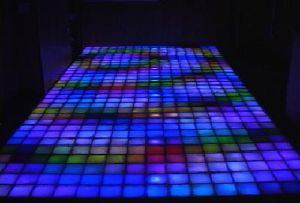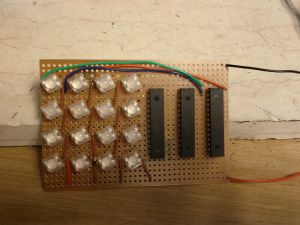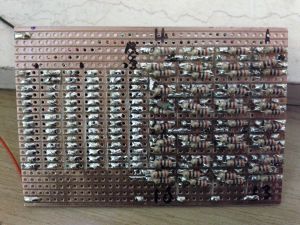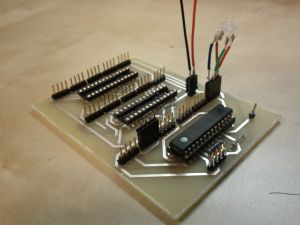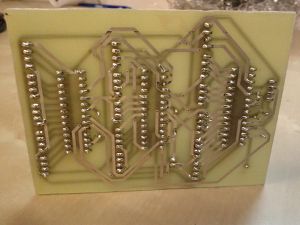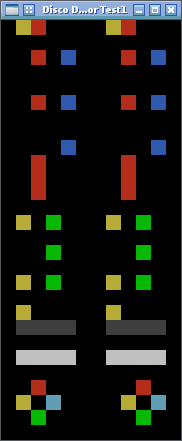Project:USB Disco Dance Floor/v1
| USB Disco Dance Floor | |
|---|---|
| Created | 2011-03-31 |
| Version | 1 |
| Members | DMI |
| Project Status | Prototyping |
| QR code | |
Introduction
The aim of this project is to create a USB-controlled, Arudino-powered 70's-style disco dance floor, inspired by a similar project by a student at MIT. It will act as a modular, low-resolution RGB display. Each pixel will be 6-8" per side, and it will come in 4x4-pixel modules that can be connected together.
The board, firmware, and controller software will (of course) be open-sourced.
Terminology
Each pixel will be referred to as a cell, and each self-contained block of 4x4 pixels will be referred to as a module.
Construction
Prototype
The prototype is just a small bit of veroboard (in fact, slightly too small... it is one hole shorter than I really wanted!) with the traces cut between holes using a Dremel.
Materials
I plan for the main body of the module to be made of wood, with some sort of frosted/diffused acrylic top. It needs to be strong enough to handle a relatively large number of people jumping up and down on it, as well as potentially spilling drinks etc.
Project log
- 2011-03-29
-
- I am building the prototype circuit on veroboard: one 4x4 array of RGB Piranha LEDs, plus three TLC5940 drivers.
- I have yet to decide whether the ICs will be assigned one per colour or just sequentially tie the outputs to the LED pins. I should be able to get 4096 levels per output channel, so this gives me (apparently) 68.7 billion colours per pixel (4096³), which should probably be enough. I'll probably reduce that down to the more standard 256 levels.
- A quick test on breadboard showed that I can at least control one TLC5940 and 5 LEDs as expected, with a sweeping pattern across the outputs. Next stage is doing exactly the same on the veroboard prototype!
- 2011-04-03
-
- I have finished soldering the LED array onto the board, including resistors, and I have now made a start on wiring the LEDs to the controllers. I also connected all of the common anodes
- I decided to connect the LEDs to the drivers sequentially, so R0 -> OUT00, G0 -> OUT01, B1 -> OUT02, etc. This was partially prompted by designing a PCB for future use. I hope to have a prototype of the board produced professionally, so I can test and refine it. A future version of the board will have the microcontroller embedded (as described below), or possibly done as an Arduino shield. Turning it into a shield is unlikely, however: the board would be quite large, and routing might be complex. It would likely be more than my version of Eagle can handle!
- 2011-04-10
-
- The prototype PCB has arrived, but I'm not sure it will be the final design. Might be worth playing with, however. Perhaps I will solder it with chip holders instead of soldering the chips directly.
- I have also considered the merits of having an onboard 4-port USB 1.1 hub and thinking about autodetecting module relative position and orientation
- 2011-04-12
-
- I finished soldering the required pins for the first chip's connection to the Arduino, which means that in theory the first five LEDs could be controlled correctly. I just have to wire them in!
- 2011-04-14
- First version of the firmware written, but untested.
- Bother. After soldering in the connections for the first four LEDs, there was a problem with LED2: no matter what the firmware specified, it would be full-brightness green. It appears to be a problem with the chip itself, so something needed to be done.
- Ended up soldering the PCB (with help from Samthetechie) and currently awaiting spare TLC5940s to arrive from TI. I love their "free sample" service! I also plan to redesign the PCB to be smaller and use smaller trace widths, as well as reorganise a couple of components.
- 2011-04-15
-
- Redesigned the PCB as described above and ordered a prototype from Spirit Circuits again. This board should be more solder-friendly due to thinner traces (smaller thermal area) and copper hints about what goes where. As another new feature, this board has mounting holes set at the corners of a 2.5" square. The board itself is 3.35" by 2.83". With luck, I should be able to fit 12 of these on a 1sqft panel via Spirit Circuits' eBay store, so each PCB would cost in the region of £2.
Future directions
Version 2 of this project will provide RGB+UV for each cell, with pressure sensors. Ideally the pressure sensors will have a resolution of one cell, so that the floor could be used for games (e.g. Tetris or a mash-up of Dance Dance Revolution and Guitar Hero). The Arduinos (or other microcontrollers) will be embedded into the board design, and the PCBs batch-produced. The board will also have a 4-port USB hub built into it, for inter-module communication.
Note: Tetris requires 10px wide by 20 high for the playing field. DDR would require ((NPlayers * 5) - 1)px wide. It looks like the floor would have to therefore be a minimum of 3x8 modules for Tetris, and probably the same for DDR (but perhaps shorter). For two players, DDR requires a minimum of 3 modules wide, but the height could be relatively variable. The example floor to the right is 3x7 modules.
